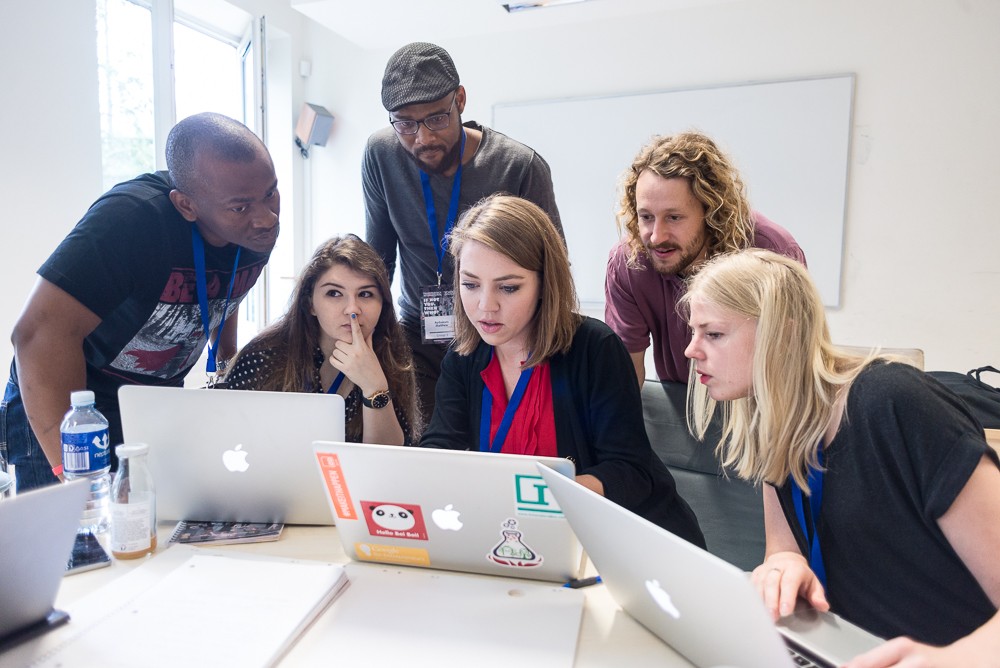Do We Know Who Controls Our State-Owned and Municipality-Owned Enterprises?
¿Sabemos quién controla a las empresas estatales y municipales?
With the growing momentum towards beneficial ownershipDisclosing beneficial owners — those who ultimately control or profit from a business — is essential for combating corruption, stemming illicit financial flows, and fighting tax evasion. Technical... More transparencyAccording to OGP’s Articles of Governance, transparency occurs when “government-held information (including on activities and decisions) is open, comprehensive, timely, freely available to the pub... More, we should also look at its less explored area, state-owned (SOE) and municipality-owned (MOE) enterprises. Identifying and monitoring who owns and controls SOEs and MOEs is key to open government since those are the companies that are closest to the people.
In many countries SOEs and MOEs are the main providers of essential public services, their functioning has a great impact on citizens’ daily life and the rest of the economy. The International Monetary Fund calculates that over the past decade, the share of SOE assets among the world’s 2,000 largest firms has doubled to 20 percent.
In Lithuania in 2020, there were 10 state-owned enterprises amongst the largest top 100 companies by revenue. However, while state-owned enterprises continue expanding in size and economic development, there is a lack of publicly available data and understanding of who actually controls them and what other interests may be at play. This is why we at Transparency International Lithuania decided to take a more in-depth look at them in Lithuania.
What did we do?
In 2019, we gathered data about the executives of 100 largest municipality-owned enterprises and all state-owned enterprises seeking to understand what is the likelihood of possible conflicts of interestA key part of anti-corruption involves preventing or revealing conflicts of interest — when a public official is in a position to use public office for personal or private gain. Technical specificat... and politicization within these companies.
More specifically, we collected and analysed data on:
- who the CEOs of these enterprises are by sending out Freedom of Information (FOIA) requests to each out of 100 largest MOEs and some municipalities in cases when MOEs did not provide the information; data about SOE executives was received from the Governance Coordination Centre in Lithuania;
- what their political affiliations are by using open dataBy opening up data and making it sharable and reusable, governments can enable informed debate, better decision making, and the development of innovative new services. Technical specifications: Polici... about participation in electionsImproving transparency in elections and maintaining the independence of electoral commissions is vital for promoting trust in the electoral system, preventing electoral fraud, and upholding the democr... More available on the Central Electoral Commission’s website; and
- how often changes in senior leadership happen after the elections by collating data about changes in the position of CEO with information about participation in elections, and comparing it with the data gathered in 2017.
What did we learn?
Despite having a better picture of who runs state- and municipality-owned enterprises in Lithuania, we also learned that 1 out of 10 SOE and 4 out of 10 MOE executives were connected to political parties in 2019, i.e. have previously participated in elections with a political party or coalition. Overall, the situation has slightly improved since 2017 when 4 out of 10 executives were affiliated with political parties, while in 2019, at least 3 out 10 SOE and MOE CEOs had such connections.
In 2019, every third municipality-owned enterprise and every fifth state-owned enterprise saw changes in senior leadership. Since the 2019 municipal elections in Lithuania in March, 25 MOEs have already changed their CEOs by the end of the year. Four of them – twice.
It took more than 100 FOIA requests to municipalities and their enterprises, and some data-matching to only grasp who ultimately runs the SOEs and MOEs. While such data on CEOs of state-and-municipality owned enterprises could have been obtained in bulk from the Center of Registers saving public resources and time that takes filing and answering numerous individual FOIA requests, it has been subject to a paywall.
What did we takeaway?
We learned all of this from gathering and analyzing data about CEOs only. Similar information about the board members of those enterprises might further tip the scales.
Knowing who controls our companies is important to empower citizens to demand accountability from governments and decision-makers. More openness and transparency is necessary for proper monitoring of conflicts of interests, effective use of public funds and fraud prevention. Especially when taking into account that almost 7 out of 10 Lithuanian residents think that party favouritism is one of the most widespread forms of corruption in the country (Lithuanian Map of Corruption, 2021).
Since currently beneficial ownership disclosure requirements in different countries may depend on legislation in place as well as on how each enterprise is organised (e.g. whether it is a legal entity or listed in the stock exchange), SOEs and MOEs should themselves publish information on who owns and controls them. Transparency International’s 10 anti-corruption principles for state-owned enterprise state that reporting may also include any kind of holdings by relatives of politicians and public officials who might influence or could be seen by the public as influencing the governance and operations of the SOE.
What is the future of beneficial ownership transparency?
Governments must not only ensure that such registers are created but also disclose them in open data format for free including specific information on who controls state-and-municipality owned enterprises. We should increase the quality and interoperability of data such as using the Beneficial Ownership Data Standard to search and cross reference globally. Revealing true owners will save money, manage corruption and money laundering risks better, and ensure fairer markets.
Recently Lithuania also joined 32 other OGP countries committing to ensure public access to beneficial ownership data through their OGP action plans. While it was a long journey, we hope that it will drive forward the conversation about the importance of knowing who are the true owners of companies and who controls them.
Find the entire analysis here. Learn more about Transparency International Lithuania here.
En el marco del movimiento por la transparencia en beneficiarios reales, es importante también pensar en un tema menos explorado, las empresas estatales y municipales. Identificar y monitorear a las entidades que controlan a las empresas estatales y municipales es fundamental para el gobierno abierto, pues éstas son las empresas más cercanas a la gente.
En muchos países, las empresas estatales y municipales son los proveedores más importantes de los servicios públicos básicos, por lo que tienen un gran impacto en la vida de la ciudadanía y en la economía. El Fondo Monetario Internacional calcula que en la última década la participación de las empresas estatales en las 2 000 empresas más importantes del mundo se ha duplicado para alcanzar el 20 %.
En 2020, en Lituana había 10 empresas estatales entre las 100 empresas más importantes del país. Aunque las empresas estatales siguen creciendo en tamaño y en desarrollo económico, no hay datos públicos o información sobre quién las controla y qué intereses podrían proteger. En ese contexto, Transparencia Internacional Lituania decidió llevar a cabo un análisis más profundo.
¿Qué hicimos?
En 2019, reunimos datos sobre los directores de las 100 empresas municipales más importantes y sobre todas las empresas estatales con el fin de identificar la posibilidad de conflictos de interés y la politización dentro de estas empresas.
Específicamente, colectamos y analizamos datos sobre:
- los directivos de estas empresas, enviando solicitudes de información a las 10 empresas municipales y a algunos gobiernos municipales en los casos en los que las empresas no entregaron información. Además, colectamos sobre los directivos de las empresas estatales a través del Centro de Coordinación de Gobernanza de Lituania;
- sus afiliaciones políticas, utilizando los datos sobre su participación en elecciones que están disponibles en el sitio web de la Comisión Central Electoral y
- la frecuencia de los cambios en las direcciones después de las elecciones, cotejando datos sobre los cambios en las direcciones con información sobre su participación en elecciones y comparándolo con los datos de las elecciones de 2017.
¿Qué descubrimos?
Además de tener una mejor idea de quien controla las empresas estatales y municipales de Lituania, identificamos que 1 de cada 10 directivos de las empresas estatales y 4 de cada 10 directivos de empresas municipales tenían vínculos con partidos políticos en 2019, es decir habían participado en elecciones con un partido político o coalición. En general, la situación mejoró ligeramente desde 2017, cuando 4 de cada 10 directivos estaban vinculados con partidos políticos, mientras que en el 2019 al menos 3 de cada 10 directivos de empresas estatales y municipales tenían tales vínculos.
En 2019, una de cada tres empresas municipales y una de cada cinco empresas estatales tuvo cambios de dirección. Desde las elecciones de Lituania que se llevaron a cabo en marzo de 2019, 25 empresas municipales ya habían cambiado de directivo para finales de año. Cuatro de ellas cambiaron dos veces.
Para entender quién tiene control de las empresas estatales y municipales fue necesario enviar más de 100 solicitudes de información a los gobiernos municipales y sus empresas, además de hacer análisis de datos. Aunque pudimos haber obtenido datos a partir del Centro de Registros y ahorrar tiempo y recursos públicos además del tiempo que implica enviar y responder a las solicitudes de información, esto estaba sujeto a pagos.
¿Qué aprendimos?
Descubrimos todo esto solamente reuniendo y analizando datos sobre los directivos. Si colectamos información sobre los miembros de los consejos de estas empresas podríamos descubrir aún más.
Saber quién controla nuestras empresas es importante para empoderar a la ciudadanía y exigir que los gobiernos y tomadores de decisiones rindan cuentas. Para lograr un monitoreo de los conflictos de interés, uso efectivo de los fondos públicos y minimizar fraudes, es necesario tener mayor apertura y transparencia. Esto cobra gran importancia en un contexto en el que 7 de cada 10 ciudadanos de Lituania creen que el favoritismo es una de las formas más comunes de corrupción en el país (Mapa de corrupción de Lituania, 2021).
Ya que los requisitos de transparencia de los beneficiarios reales de los diferentes países dependen de las leyes vigentes y de la forma en la que se organizan las empresas (por ejemplo si son entidades legales o cotizan en la bolsa), las empresas estatales y municipales deben publicar información sobre quienes las controlan. Los 10 principios de lucha contra la corrupción en las empresas estatales de Transparencia Internacional determinan que los reportes también deben incluir a los parientes de los políticos y funcionarios que podrían influir en la gobernanza y operaciones de las empresas estatales.
¿Cuál es el futuro de la transparencia en los beneficiarios reales?
Los gobiernos no solo deben asegurarse de crear registros, sino además de publicarlos en formato abierto y sin costo, incluyendo información sobre quién controla las empresas estatales y municipales. Debemos incrementar la calidad e interoperabiliad de los datos, por ejemplo utilizando el Estándar de Datos de Beneficiarios Reales para poder realizar búsquedas y cruces a nivel mundial. Revelar los beneficiarios reales ahorrará dinero, reducirá riesgos de corrupción y lavado de dinero y promoverá mercados más justos.
Recientemente, Lituania se unió a otros 32 países de OGP que se comprometieron a asegurar el acceso público a datos sobre beneficiarios reales a través de sus planes de acción de OGP. Aunque ha sido un camino largo, esperamos que contribuirá a la conversación sobre la importancia de saber quién controla las empresas.
Para leer el análisis completo, haz clic aquí. Para saber más sobre Transparencia Internacional Lituana haz clic aquí.



Oliver Mupila Kameya Reply
I’m interested and I’m looking at the Zambian situation after the 12 August 2021. General Elections.